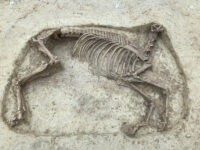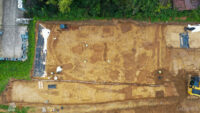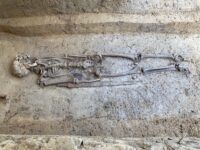 Archaeologists have unearthed a Merovingian-era cemetery in Knittlingen, southwestern Germany, that includes a beheaded horse laid to rest alongside his warrior rider. The excavation revealed more than 110 graves containing the remains of the local elite.
Archaeologists have unearthed a Merovingian-era cemetery in Knittlingen, southwestern Germany, that includes a beheaded horse laid to rest alongside his warrior rider. The excavation revealed more than 110 graves containing the remains of the local elite.
Today’s Knittlingen was founded in the Merovingian period (the first written record of it is Carolingian, dating to 843), but there is archaeological evidence of settlement going back to the Neolithic era. Graves from the Merovingian burial ground were first discovered in 1920 during construction of a narrow-gauge railway that was never completed. When real estate development was planned at the site in the 1980s, an archaeological survey encountered a few more graves, but the development did not move forward and the site was not thoroughly excavated until this summer.
 The Baden-Württemberg State Office for Monument Preservation (LAD) employed contractors ArchaeoBW to explore the area. As expected, the team encountered prehistoric findings, post holes, pits and trenches from Neolithic structures and fragments of ceramics dating to around 5000 B.C.
The Baden-Württemberg State Office for Monument Preservation (LAD) employed contractors ArchaeoBW to explore the area. As expected, the team encountered prehistoric findings, post holes, pits and trenches from Neolithic structures and fragments of ceramics dating to around 5000 B.C.
The main focus of the excavation, however, was the Merovingian cemetery. The goal was to uncover all of the inhumation burials at the site, and even though excavations will continue through the spring of 2022, archaeologists believe the cemetery has been fully revealed.
 The graves were laid out in regular rows in largely chronological order, but the graves of some of the more notable members of the societal elite were out of sequence, buried within a circular ditch. Some of the graves were simple cut holes, but some individuals were buried in wooden coffins, and there were also more elaborate wooden chambers built to contain the remains of people of highest status.
The graves were laid out in regular rows in largely chronological order, but the graves of some of the more notable members of the societal elite were out of sequence, buried within a circular ditch. Some of the graves were simple cut holes, but some individuals were buried in wooden coffins, and there were also more elaborate wooden chambers built to contain the remains of people of highest status.
While the cemetery was extensively looted in the Middle Ages, archaeologists were able to recover a wide range of funerary artifacts, including pearl necklaces, fibulae, earrings, arm rings, disc brooches, belt fittings and utilitarian objects like knives and combs. Weapons — swords, spears, shields, arrowheads — were found in male burials. Pottery containing the remnants of food were interred as funerary offerings.
“Despite their fragmentation due to the ancient robbery, the finds give indications of the social status of the dead,” said [LAD officer Dr. Folke] Damminger. The comparatively rich burials from the second half of the sixth century are remarkable in Knittlingen. One woman was buried with almost complete fibula outfits typical of the time. A gold disc brooch worn individually from a somewhat younger grave, on the other hand, heralds the fashion of the seventh century. Some of the men’s graves identified the deceased as cavalrymen. A decapitated horse was buried in the vicinity of one of these burials. Bronze bowls testify to table manners based on the courtly model.
The accessory ensembles of the late seventh century, on the other hand, looked somewhat more modest. It is not known whether this is due to a decline in prosperity or to a change in the staging of the funerals of the local elites.